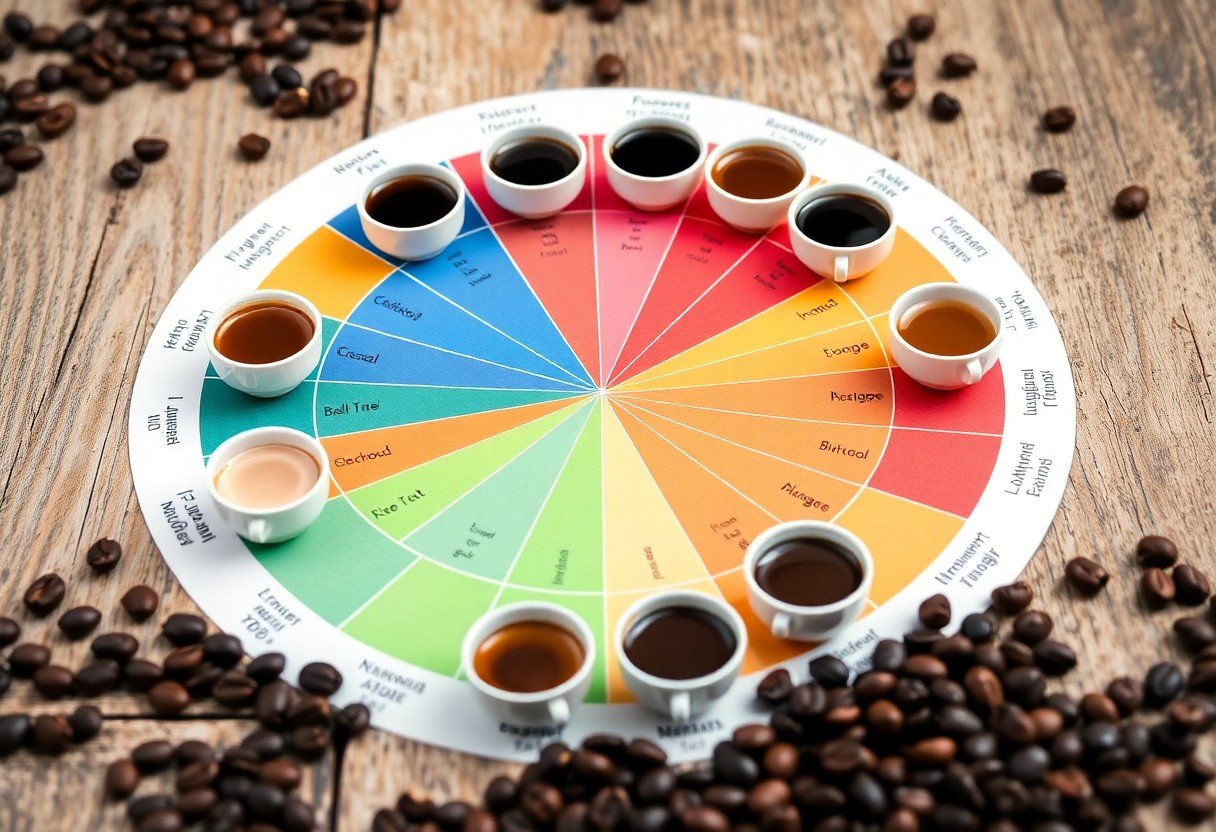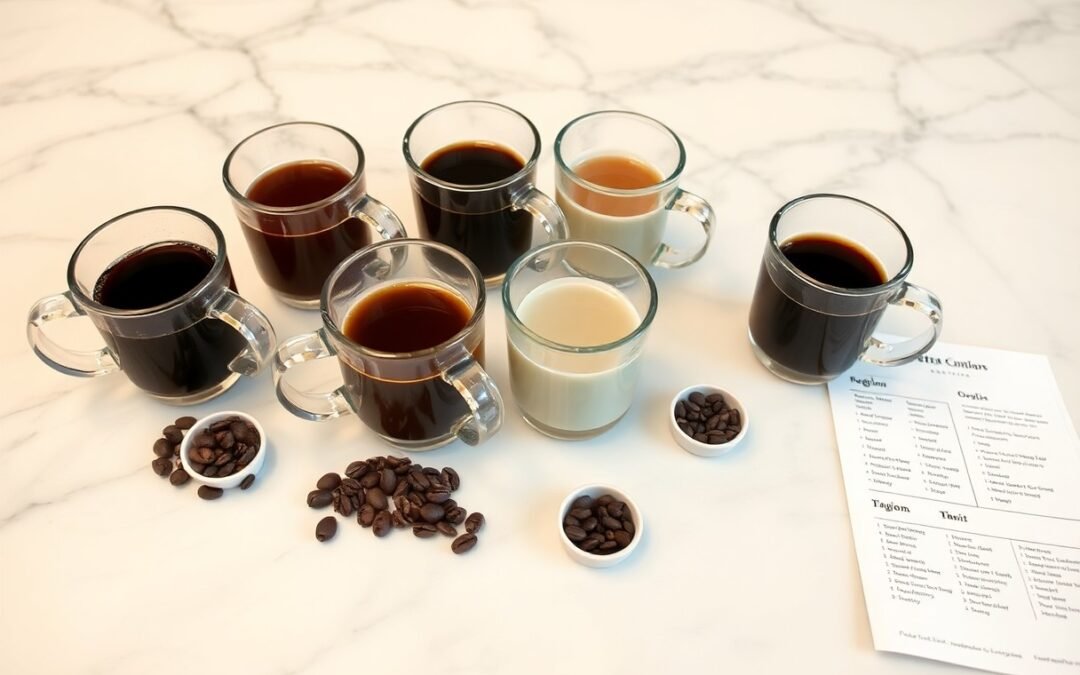Just entering into the world of artisan coffee can be overwhelming, especially when it comes to understanding the distinct flavor profiles that vary across different regions. You’ll discover how factors like soil composition, climate, and local processing methods influence taste, allowing you to appreciate each brew’s unique character. This guide will equip you with practical techniques to effectively compare and savor the nuanced flavors from various coffee-growing areas, enhancing your brewing experience and deepening your appreciation for this beloved beverage.

Decoding the Origin: Terroir and Its Impact on Flavor
Understanding the concept of terroir in coffee is crucial as it significantly influences the flavor characteristics of your cup. Terroir encompasses various elements, including geography, climate, and human cultivation practices that shape how beans develop their unique taste profiles. Each coffee-growing region has distinct attributes, making it vital for you to recognize how these factors contribute to the overall flavor experience.
The Science of Terroir: How Geography Shapes Coffee
Geography plays a pivotal role in the taste of coffee, as it encompasses more than just location—it includes the specific terrain, elevation, and proximity to bodies of water. For instance, coffees from the high altitudes of Colombia often exhibit bright acidity and complex flavors, while beans from lowland regions may have mellower profiles. The interplay of these geographic factors fundamentally defines the aromatic and flavor nuances you can expect.
Climate, Soil, and Altitude: Key Factors in Flavor Development
Your coffee’s flavor is deeply influenced by climate, soil composition, and altitude. Higher altitudes contribute to slower bean maturation, leading to more concentrated sugars and enhanced acidity. Likewise, varying soil types impart distinct mineral qualities to the beans, influencing the depth of flavors. The climate, with its temperature and rainfall patterns, defines not only the growth cycle but also the aromatic complexity of the coffee, which you will find in each cup.
- Altitude affects maturation speed and acidity.
- Soil type influences availability of nutrients and flavor profile.
- Climate determines growth cycles, affecting overall flavor nuances.
- Knowing the relationship between these elements will enhance your appreciation for different coffees.
Specific factors like temperature ranges also play a role in flavor development. For example, high-temperature variations between day and night can enhance a coffee bean’s acidity and complexity, resulting in vibrant tasting notes. Furthermore, nutrient availability in soil due to volcanic activity in regions like Ethiopia nurtures unique flavor characteristics that can be found in their beans. Understanding these details helps you make informed choices in your coffee journey.
- Nuanced temperature variations can elevate acidity and complexity.
- Volcanic soils provide crucial nutrients that enhance flavor uniqueness.
- Identifying distinct attributes through tasting can enrich your exploration of artisan coffees.
- Knowing these insights leads to a deeper connection with the coffee you enjoy.

The Flavor Wheel: Navigating Nuances in Coffee Tasting
A comprehensive understanding of the coffee flavor wheel can significantly enhance your tasting experience, allowing you to identify and appreciate the diverse flavors present in different brews. This tool categorizes flavors into distinct groups—fruity, nutty, floral, and more—helping you navigate the complex profiles that emerge from various regions and processing methods. By using the flavor wheel, you can pinpoint specific notes, making your coffee tastings more insightful and enjoyable.
Understanding the Coffee Flavor Wheel: A Comprehensive Breakdown
The coffee flavor wheel organizes flavors into categories, making it easier for you to identify and articulate what you taste. At the center, you’ll find broad categories like “Fruity” or “Nutty,” which branch out into more specific flavors such as “Blackberry” or “Almond.” This hierarchical structure not only expands your vocabulary but also enhances your ability to communicate tasting notes with others, fostering a deeper appreciation for the intricacies of coffee.
Identifying Tasting Notes: How to Recognize and Describe Flavors
Recognizing tasting notes in coffee involves engaging your senses and drawing upon your experiences with different flavors. Smelling and tasting side by side helps you link familiar aromas and tastes to specific notes on the flavor wheel. For instance, when tasting a Kenya coffee, you might pick up notes of berry, citrus, or wine-like qualities. Keep a flavor journal to document your experiences, making it easier to draw connections and communicate your findings effectively.
To identify tasting notes accurately, focus on the aroma before sipping. Swirl the cup to release volatile compounds and inhale deeply; you might notice floral scents or hints of chocolate. As you take a small sip, let the coffee linger on your palate. Consider the sweetness, acidity, and body while noting any specific flavors you detect. Comparing your notes to the flavor wheel can validate your impressions, reinforcing your ability to describe the diverse flavor profiles that make artisan coffee so captivating. Over time, you’ll develop a refined palate capable of distinguishing subtle nuances across different regions.
Comparative Analysis: Exploring Regional Flavor Distinctions
Different coffee-growing regions impart distinct flavor characteristics to beans. Geographic factors, including altitude, climate, and soil composition, shape these profiles. By understanding these distinctions, you enhance your coffee experience and can make informed choices based on your flavor preferences.
| Region | Flavor Profile Highlights |
|---|---|
| Ethiopia | Floral notes with bright acidity and hints of berry. |
| Colombia | Well-balanced with caramel sweetness and nuttiness. |
| Brazil | Chocolatey with low acidity and a smooth body. |
| Kenya | Citrusy acidity with vibrant fruit flavors. |
From Ethiopia to Colombia: Highlights of Regional Profiles
Ethiopian coffees typically offer a complex florality and vibrant berry essences, creating a lively cup. In contrast, Colombian varieties showcase a balance of techniques that yield rich caramel and nutty undertones, often accompanied by a medium body and pleasant acidity. These regional highlights not only differentiate the tasting experience but also reflect the unique agricultural practices and climate conditions of each locale.
The Role of Processing Methods in Flavor Variation
Processing methods significantly influence the final flavor profile of coffee. The choice between washed, natural, or honey processing alters how flavors develop during fermentation and drying. Washed coffees often yield cleaner, brighter flavors, while natural processes tend to enhance fruitiness and body. Each method brings out unique characteristics that resonate with particular regions, shaping your tasting experience.
For instance, Ethiopian coffees often utilize natural processing, resulting in intense fruity notes and a fuller mouthfeel, while many Colombian coffees undergo washed processing, leading to clarity and a more refined flavor profile. The differences arise because natural processing leaves the cherry’s fruit intact during drying, allowing sugars to infuse into the bean, while washed processing removes the fruit early, emphasizing the bean’s inherent profile. Understanding these methods is critical for appreciating the full spectrum of flavors in your cup.
Cultivating Your Palate: Techniques for Flavor Comparison
| Technique | Description |
|---|---|
| Blind Tasting | Sample coffees without knowing their origins to prevent bias and focus purely on flavor. |
| Flavor Pairing | Pair different coffee profiles with contrasting food or beverages to identify unique tastes. |
| Side-by-Side Comparison | Taste multiple coffees at the same time to evaluate distinct flavor notes more accurately. |
Practical Tasting Techniques: How to Host a Flavor Profiling Session
To create an effective flavor profiling session, gather a variety of coffees from different regions. Use a standardized cupping method to ensure consistency. Each participant should have tasting notes handy to jot down specific flavors, aromas, and impressions for each coffee. Encourage a structured discussion based on individual observations, fostering a collaborative environment that exposes different perspectives on flavor profiles.
Building a Flavor Library: Documenting Your Coffee Experiences
Your flavor library should be a curated collection of notes, descriptions, and preferences from your coffee tastings. Document specific attributes you identify throughout each session, including origin, roast level, and flavor notes. This will help you trace preferences and deepen your understanding of how certain characteristics relate to particular regions.
Building a thorough flavor library enhances your coffee experience by enabling you to reflect on your tasting journey. By cataloging not just descriptions but also personal insights—like the moods or settings experienced while tasting—you develop a more profound connection with each coffee. Utilize a notebook, digital app, or even a social media platform dedicated to coffee, ensuring quick access to your evolving palate preferences and aiding in future comparisons.
Cultural Influences on Coffee Consumption and Preferences
Understanding cultural nuances enhances your appreciation of diverse coffee experiences. Each region’s unique customs and historical contexts mold local preferences, influencing how coffee is prepared, served, and savored. From the French café culture to the Brazilian espresso rituals, these practices not only highlight distinct flavor profiles but also underscore the social aspects of coffee enjoyment, revealing deeper connections between people and their daily brews.
How Tradition Shapes Taste: Global Perspectives on Coffee
Traditions in coffee consumption shape the flavor profiles that you might favor. In Ethiopia, coffee ceremonies emphasize the raw bean’s earthy flavors through meticulous preparation, while Italian espresso culture champions intense, bold profiles crafted for quick consumption. These traditions reflect local agricultural practices and palate development, providing a fascinating view of how geography influences taste expectations.
The Evolution of Flavor Preferences in Different Coffee Cultures
Flavor preferences have shifted over time, influenced by globalization and exposure to diverse brewing methods. In recent years, coffee cultures have begun embracing lighter roasts and single-origin beans, moving away from the darker roasts once popular in many regions. For instance, the rise of specialty coffee shops in the United States has introduced complex flavor profiles, leading consumers to appreciate nuanced tasting notes previously overlooked. This evolution illustrates the adaptability of taste and how external factors can redefine coffee appreciation.
Expanding on this evolution, you’ll find that regional coffee preferences continuously adapt to global trends and economic shifts. For example, the increasing accessibility of direct trade relationships has allowed consumers to explore and compare flavors from remote regions. As you travel or engage with global coffee communities online, you may notice this shift reflected in your own taste as you begin to seek out lighter, fruitier coffees, mirroring shifts observed in Japan and Scandinavian countries. This growing trend emphasizes the dynamic nature of coffee culture, where diverse influences foster a richer understanding and appreciation of various flavor profiles.
Conclusion
Drawing together the diverse elements of artisan coffee flavor profiles can enhance your appreciation and knowledge of this complex beverage. By carefully examining the factors that influence taste—such as origin, processing methods, and roasting techniques—you can develop a more nuanced understanding of coffee from different regions. Engaging your senses and keeping detailed notes will allow you to compare and contrast flavors, ultimately elevating your coffee experience and enabling you to choose brews that resonate with your personal preferences.
FAQ
Q: What are the main factors affecting the flavor profiles of artisan coffee?
A: Key factors include the coffee variety, growing conditions (altitude, climate, soil), processing methods, and roasting techniques.
Q: How do I identify different flavor notes in artisan coffee?
A: Use sensory evaluation methods, such as cupping, to assess aroma and taste. Look for specific characteristics such as fruitiness, nuttiness, acidity, and sweetness.
Q: What role does the region of origin play in coffee flavor?
A: The region impacts flavor due to distinctive climate and soil conditions. For example, Ethiopian coffees often have floral and fruity notes, while Colombian coffees may be more balanced and nutty.
Q: How can I effectively compare coffees from different regions?
A: Conduct blind tastings with samples from each region. Take detailed notes on aroma, flavors, acidity, and body to evaluate the differences objectively.
Q: Are there specific brewing methods that highlight certain flavor profiles?
A: Yes, brewing methods such as pour-over or French press can enhance different flavor notes. Experiment with grind size, water temperature, and brewing time to optimize the flavor experience.

